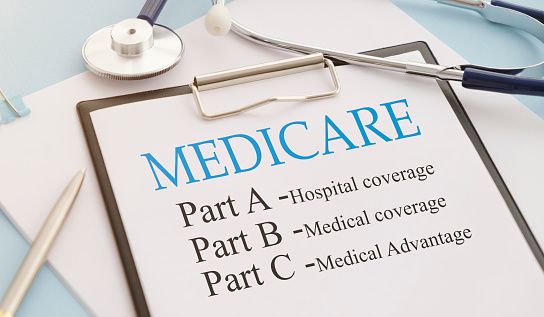Whether you’re new to Medicare or want to stay up-to-date on the latest changes, this guide will walk you through everything you need to know. We’ll cover eligibility requirements and options and choose the right plan for you.
So whether you’re nearing retirement or want to start planning, read on for all the information you need about Medicare.
What Is Medicare And What Does It Cover?
Medicare is a federal health insurance program for people 65 or older, those under 65 with specific disabilities, and those of any age with End-Stage Renal Disease (ESRD).
Currently, there are four parts to Medicare, namely Part A: is all about Hospital Insurance Part B: Medicare Insurance Part C: Medicare Advantage Plans Part D: (Prescription Drug Coverage).
Most people eligible for Medicare plan contribute to the program through their payroll taxes while working.
Original Medicare, Part A and Part B cover a wide range of medical services and supplies. Hospitalizations, skilled nursing facility care, hospice care, and some home health care are some of the benefits covered by Part A. In Part B, doctors’ visits, outpatient care, and medical supplies are covered.
If you have Original Medicare, you can also add a private supplemental insurance policy known as Medigap to help pay some out-of-pocket costs not covered by Medicare.
Medicare Advantage Plans (Part C) is an alternative to Original Medicare. Private insurers approved by Medicare offer these plans. If you enroll in a Medicare Advantage Plan, you will still have Medicare Parts A and B, but your benefits will be provided through a private insurer. Most Medicare Advantage Plans also offer prescription drug coverage (Part D).
Medicare Part D, helps pay for the cost of prescription drugs. Private insurers approved by Medicare offer this coverage. You can get this coverage through a stand-alone Part D plan or as part of a Medicare Advantage Plan that includes drug coverage.
If you are eligible for Medicare, you can enroll in Parts A and B through the Social Security Administration. You can also enroll in Part C and Part D through private insurers.
If you have questions about your eligibility or how to enroll, you can contact the Social Security Administration at 1-800-772-1213 or visit the social security website. You can also contact Medicare directly at 1-800-MEDICARE (1-800-633-4227).
How Do I Qualify For Medicare?
To qualify for Medicare, you must be a U.S. citizen or permanent resident 65 years or older. You may also qualify if you are under 65 and have a disability, End-Stage Renal Disease, or Amyotrophic Lateral Sclerosis. If you are under 65 and have a qualifying disability, you must provide proof of your disability when applying for Medicare.
If you are under 65 and have End-Stage Renal Disease, you must provide proof of your diagnosis when applying for Medicare. You may be able to get Medicare coverage before you turn 65 if you are a disabled widow or widower.
To apply for Medicare, you can contact your local Social Security office or visit the Social Security website. You will need to provide basic information about yourself, such as your name, date of birth, and Social Security number.
You will also need proof of your citizenship or permanent residency status. Once you have applied for Medicare, you will receive a card in the mail that you can use to access your benefits.
You will automatically be enrolled in Medicare Part A if you already receive Social Security benefits. If you are not receiving Social Security benefits, you can enroll in Medicare through the Health Insurance Marketplace. You can also enroll in Medicare by contacting your state’s Medicaid office.
How Much Will I Have To Pay For Medicare?
You might wonder how much you’ll have to pay for Medicare. The answer depends on several factors, including your income, your assets, and whether you have a health insurance plan that provides Medicare coverage.
If you’re single and have an annual income of $85,000 or less, you’ll pay $135 per month for Part B coverage. If your income is higher than $85,000, you’ll pay more. For Part D prescription drug coverage, you’ll pay a premium of $33.50 per month if you have an annual income of $85,000 or less.
Again, if your income exceeds $85,000, you’ll pay more. In addition to the premiums you’ll pay for Part B and Part D coverage, you may also be responsible for deductibles, copayments, and coinsurance. For example, the standard Part B deductible was $203 in 2021.
You’ll pay the first $203 of covered medical expenses yourself. After that, Medicare will start to pay its share. You can expect to pay similar deductibles. Copayments are usually a set amount you pay for a covered service (for example, $20 for a doctor’s visit).
Coinsurance is usually a percentage of the cost of a covered service that you pay (for example, 20% of the cost of a hospital stay). You’ll most likely pay copayments and coinsurance only after you’ve met your deductible. There are also some services that Medicare doesn’t cover at all.
You’ll have to pay for these services or get them covered by a supplemental insurance plan. Examples of services that Medicare doesn’t cover long-term care, dental care, and eye exams. You can expect to pay similar deductibles.
As you can see, several factors can affect how much you’ll pay for Medicare coverage. Your best bet is to contact the Social Security Administration or your local Medicare office to get specific information about premiums, deductibles, and other costs.
What Are The Penalties For Not Enrolling In Medicare On Time?
Many people are unaware of the penalties for not enrolling in Medicare on time. If you are over 65 and not enrolled in Medicare, you may be subject to a late enrollment penalty. This penalty is assessed by the Social Security Administration and is based on the number of months you were eligible for Medicare but not enrolled.
The penalty is applied to your Medicare Part B premium, which you pay for outpatient services. The penalty amount is 10% for every 12 months you were eligible for Medicare but not enrolled.
In addition, if you are not enrolled in Medicare Part A (hospital insurance), you may also be subject to a late enrollment penalty. This penalty is 2% of the national average monthly Part A premium, multiplied by the number of months you were eligible but not enrolled.
The penalty is an increase in your Part B and Part D premiums, calculated based on the months you delayed enrollment. In addition, if you go without Medicare coverage for more than 63 days in a row, you may have to pay a late enrollment penalty when you do enroll.
This penalty is also calculated based on the number of months you went without coverage. To avoid these penalties, enrolling in Medicare during your initial enrollment period is essential. You can also sign up for a Special Enrollment Period if you have other health insurance coverage, such as through an employer, or if you qualify for a hardship exemption.
If you’re unsure when your initial enrollment period begins, or if you have questions about enrolling in Medicare, contact the Social Security Administration.
Conclusion
The final decision on your best plan will come down to your specific needs and budget. We hope this guide has helped you understand the different aspects of Medicare and given you a better idea of what plan might be right for you. Remember, it’s never too late to switch plans if something doesn’t seem quite right or if your needs change during the year.
- Pet Insurance: Is it Really Necessary
- AAA Membership for Seniors – What Are the Pros and Cons
- Senior Vision Insurance Options And Ways To Save
- Seniors Guide to Annuities Investing
- Skincare and Wrinkle Prevention for Seniors


